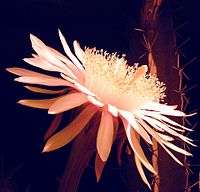Acanthocereus tetragonus
Acanthocereus tetragonus is a species of cactus that is native to Florida and the Lower Rio Grande Valley of Texas in the United States, Mexico, Central America, Caribbean, and northern South America. Common names include night-blooming cereus,[4] barbed-wire cactus,[2] sword-pear,[2] dildo cactus,[5] triangle cactus,[2] and Órgano-alado de pitaya (Spanish).[3] It was originally described by Carl Linnaeus in 1753 as Cactus tetragonus but was moved to the genus Acanthocereus in 1938 by Pieter Wagenaar Hummelinck.[2]
| Acanthocereus tetragonus | |
|---|---|
 | |
| Scientific classification | |
| Kingdom: | |
| (unranked): | |
| (unranked): | |
| (unranked): | Core eudicots |
| Order: | |
| Family: | |
| Genus: | |
| Species: | A. tetragonus |
| Binomial name | |
| Acanthocereus tetragonus (L.) Hummelinck | |
| Synonyms | |
|
Acanthocereus pentagonus (L.) Britton & Rose | |
Description
Acanthocereus tetragonus is a tall, columnar cactus that reaches a height of 2–7 m (6.6–23.0 ft). Stems are dark green, have three to five angles, and are 6–8 cm (2.4–3.1 in) in diameter. Areoles are grey and separated by 2–3 cm (0.79–1.18 in). Central areoles have one to two spines up to 4 cm (1.6 in) long, while radial areoles have six to eight spines up to 2.5 cm (0.98 in) in length.[6] The flowers are 14–20 cm (5.5–7.9 in) in diameter with a tube 8–15 cm (3.1–5.9 in) in length.[7] Outer tepals are greenish-white, inner tepals are pure white, and pistils are creamy white. Flowers are open from midnight until dawn, attracting hummingbird moths (Hemaris spp.). The shiny, red fruits are around 5 cm (2.0 in) long.
This highly spiny, often large, and thicket-forming cactus has stems up to 10 feet or possibly taller. It is native to the coastal hammocks and hot, dry coastal habitats and thickets and sandy coastal habitats of central and southern Florida and the Keys, south into the Caribbean. The flowers are showy and are white with a deep red and orange or red-orange center. The flowers bloom at night and close during the day. This cactus blooms a few times a year for several weeks at a time. This cactus often forms thickets in coastal hammocks which can be impenetrable and spiny.[8]


Uses
Young stems of the barbed-wire cactus can be eaten as a vegetable either cooked or raw,[4] while the fruits are edible and sweet.[8] It is sometimes cultivated as an ornamental. It is sometimes planted as a living fence. The Fairy Castle Cactus, a miniature cultivar of this species, has many curved branches that resemble the turrets of a castle.[9]
Invasiveness
The species is invasive in New Caledonia.[10]
References
- "Acacia aneura". IUCN Red List of Threatened Species. 2019. 2019. Retrieved 16 June 2019.CS1 maint: ref=harv (link)
- "Acanthocereus tetragonus". Germplasm Resources Information Network (GRIN). Agricultural Research Service (ARS), United States Department of Agriculture (USDA). Retrieved 2009-12-04.
- "Acanthocereus tetragonus". Integrated Taxonomic Information System. Retrieved 2009-12-03.
- King, Ken; Christina Mild (October 2009). "Barbwire Cactus" (PDF). The Sabal. 26 (7): 4–5.
- "Dildo Key". Key Names Gazetteer. Florida International University Digital Collections Center. Retrieved October 6, 2010.
- Anderson, Edward F. (2001). The Cactus Family. Timber Press. pp. 107–108. ISBN 978-0-88192-498-5.
- Flora of North America Editorial Committee (ed.). "Acanthocereus tetragonus". Flora of North America North of Mexico (FNA). New York and Oxford. Retrieved 2009-12-04 – via eFloras.org, Missouri Botanical Garden, St. Louis, MO & Harvard University Herbaria, Cambridge, MA.
- "Acanthocereus tetragonus (L.) Humm". Native Plant Information Network. Lady Bird Johnson Wildflower Center. Retrieved 2009-12-04.
- Lemke, Cal. "Acanthocereus tetragonus 'Fairy Castles' - Fairy Castle Cactus". Cal's Plant of the Week. Retrieved 2009-12-04.
- Hequet, Vanessa (2009). LES ESPÈCES EXOTIQUES ENVAHISSANTES DE NOUVELLE-CALÉDONIE (PDF) (in French). p. 17.
External links


